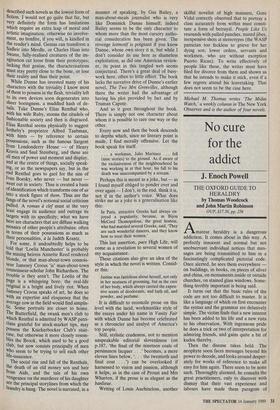No cure for the addict
J. Enoch Powell
THE OXFORD GUIDE TO HERALDRY by Thomas Woodcock and John Martin Robinson OUP, f17.50, pp. 256 Amateur heraldry is a dangerous addiction. It comes about in this way. A perfectly innocent and normal but not unobservant individual notices that mes- sages are being transmitted to him in a fascinatingly complicated pictorial code. Once alerted, he sees them everywhere on buildings, in books, on pieces of silver and china, on monuments inside or outside churches, on stained glass windows. Some- thing terribly important is being said.
It turns out that the basic rules of the code are not too difficult to master. It is like a language of which on first encounter the syntax and the grammar are delusively simple. The victim finds that a new interest has been added to his life and a new vista to his observation. With ingenuous pride he does a trick or two of interpretation for admiring friends, and gains quite a bit of kudos thereby.
Then the disease takes hold. The neophyte soon faces messages beyond his power to decode, and looks around desper- ately for works of reference to make all easy for him again. There seem to be none such. Thoroughly alarmed, he consults the great practitioners, only to discover with dismay that their vast experience and labours have made them paragons of humility — in fact, the wiser, the humbler. Too late he perceives that genealogy and heraldic history are like that `Serbonian Bog, in which whole armies have been swallowed up and lost'. His last savings are now used in acquiring — secondhand, if it proves necessary — the reputed standard works.
Such an addict will be attracted to the Oxford Guide to Heraldry by Somerset Herald and FitzAlan Pursuivant Extraor- dinary, which, with 35 excellent coloured plates, is cheap at £17.50. Let him not, however, be deceived by that word 'Guide' into imagining that his hapless lot will be relieved: far from it, the 'Guide' will only make him a worse addict than before. What it is not is the figment so often constructed by his fevered imagination, a work of reference that will answer his every query or at least tell him where the answer is to be found. It is in fact a collection of expert and thoroughly resear- ched monographs on various aspects of heraldic science: origins, foreign heraldry (including American), the separate ele- ments of a coat of arms from crest to motto, the complexities of combining arms together, and the legal control over arms in England and in Scotland. When the addict puts the book down, his addiction is only more confirmed.
He has learnt to take banners as serious- ly as shields. He knows that quartering began in Spain and spread from there to everywhere in Europe except Poland, and that Americans 'descended in an unbroken male line from subjects of the British Crown' can get honorary grants of arms. He has discovered that Cinderella's slipper was not glass (verre) but squirrel fur (vair). He has found heraldic confirmation of that mobility between classes which made Eng- land a happier and safer country than most others. He has enjoyed the advice to the young bodyguard at Madrid enquiring whom to salute: 'My friend, the safe rule is to suppose everybody in the Palace who looks like a monkey to be a grandee of the first class'. He had made a mental note to pay more attention in future to French heraldry — or Polish too, for that matter, if he gets a chance. He has spotted in the `first Soviet work on heraldry' a reference to 'new coats of arms being worked out for Soviet cities' — no knowing where peres- troika will stop! With some malicious delight he has learnt of a 'genealogical error in the Scottish Royal Lineage which appears in Burke's Peerage to this day'.
Above all, the addict's admiration and gratitude are enhanced for that power- house of historical scholarship known as the College of Arms, which has sat in Queen Victoria St, EC4 for over 300 years now, and never more vigorous than today. `The study of grants of arms', says the Guide, 'is one of the principal unexplored channels for English social history over the last four centuries, and could repay further research'. Amen.



















































 Previous page
Previous page